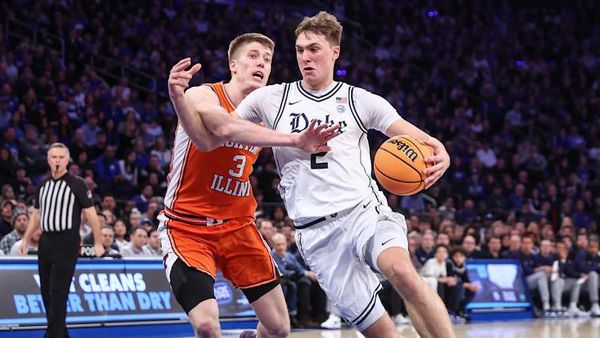As it has been for my entire career in the football business, this is the busiest time on the NFL calendar. It is counterintuitive for many—there are no games being played, players are untethered to their teams and coaches have no players to coach. But it is during this time of year, when facilities are empty and locker rooms are bare, that NFL teams separate themselves. This is when teams are built, managed, architected, assembled and prepared for 2024. The work for coaches and players does not truly begin until much later; right now, it is the front office’s time to shine.
The two areas of football operations that are front and center now are (1) college scouting, and (2) cap space and contract management.
As to the former, once the Senior Bowl ends in late January, all scouting staff—many of whom do not live where the team plays—flock to the home base. They do their most important work from late January until now, grinding through film every day from dawn to dusk in dark War Rooms, preparing the all-important “board” that ranks the prospects, by round, for April’s draft. By the time scouts leave for the combine, the board is pretty much set. Sure, there will be some tweaks and minor revisions based on combine times or pro day results, but the board is primarily built during these long and cold winter days from late January to late February.
As for the cap and contract side, it is all about planning. Scenarios are put together, along with the general manager, depending on certain contract-extension frameworks, free-agent signings and releases (and the dead money accelerations). There may be upcoming cap restructures for some players, and more delicately, cash reductions (pay cuts) for others.

Kirby Lee/USA TODAY Sports
Nonetheless, the combine is an extremely important time, for reasons having nothing to do with scouting.
The combine as a business convention
I probably attended almost 20 combines during my time as an agent and a team negotiator. In all that time, I never attended a workout. I was too busy, and it wasn’t my role. We had plenty of other people doing that.
Cap and contract managers set up shop at the combine, usually in corners of hotels (mine was the Omni in downtown Indianapolis), coffee shops or restaurants to have meetings, primarily with agents. There are meetings about players the team wants to extend or to restructure; there are meetings about players who are disgruntled with their current contract situations; and there are meetings about players the team wants to reduce or release.
Then there are the meetings about the impending free agents. Having worked with the Green Bay Packers, a team that largely eschewed free agency, I did not do much of this at the combine. As for tampering, there are certainly uses of language to avoid allegations. Teams can ask the agent: I see that your player is about to be a free agent; what would you be looking for in the marketplace? That is not tampering; that is a general question. And most agents also represent other players on the teams they are talking to, in addition to any free agents. There is always cover.
Of course, everyone knows free agency begins and often ends at the combine, with agents “prequalifying” teams and essentially knowing where the player will sign in two weeks. I was always frustrated at the combine when trying to meet with agents representing Green Bay’s own pending free agents … seeing their dance cards so full of meetings with other teams that they could not even meet with their existing team.
A bonus lesson here for agents reading this in negotiations with teams …
I often heard something along the lines of, I can make it very cap-friendly for you! That irked me, as it does every team’s cap manager. First, what that really meant was they could make it cap-friendly early but cap-unfriendly later. More importantly, the cap was not their concern; it was mine. I would politely, or not so politely, tell them: You worry about your player; I’ll worry about our cap. If you are an agent reading this, please don’t try to tell the team’s cap manager about his or her cap. That will not sit well.
Cap spike reality
There has been celebration from both sides—the league and the players—after the announcement of the 2024 salary cap number of $255 million, a healthy 13.4% increase from last year’s $224 million. With the league now past the deficits from the “Covid years,” this is what has been expected. And it’s good news for both players and teams tight against the cap.
There are a couple of caveats, though, to go along with this record number. First, the natural maturation process of player contracts can soak up most cap increases, even this year. Teams usually have 10 to 25 players with contract increases at or around $1 million a year, some at increases up to $3 to $5 million per year. The increases in contracts alone can eat up most or all of cap increases.
Also, don’t assume the teams are not at all hurt by this. NFL teams receive almost $400 million as their national disbursement from the league, shared revenue for media, licensing, sponsorships, etc. And that number, before any local revenue is earned, is almost $150 million more than the $255 million player cap. Even with a healthy salary cap, the owners still have the much better deal.
As for the pending free agents, time will tell if the high cap number will translate into new contract levels. My sense is things will be as they are every year: a handful of golden ticket winners early, followed by a mad scramble before the money runs out.
Perhaps the strong cap increase will lessen the number of cap “push-outs,” restructures where teams convert large salaries into prorated signing bonuses, deferring cap pain. The New Orleans Saints, as per their normal mode of operations, already pushed out $23 million of cap room on Derek Carr’s contract. Maybe there will be less of this (a mode of cap management that I do not like) in 2024.
Again, it doesn’t take a cap wizard to move cap to future years. It takes a cap wizard to put the team in position to not have to do that.
As for a certain powerful team weapon ...
Power of the tag
The franchise tag designation period started last Tuesday and continues through next Tuesday. The tag allows teams to take one of their pending free agents, often their best one, off the market. I say this every year: It is hard to overestimate the restrictive powers of the tag.
I know, some say—even the NFLPA, the union that continues to allow this to happen—that the tag only affects the handful of players to which it is applied each year. While technically true, that sentiment is completely wrong. Teams use the tag all the time in negotiations with their best players, although they rarely apply it. When a top player has, say, one year left on their contract, the team knows they really have two or three years left, due to the tag. A player can accept what the team is offering or later be saddled with the tag, which essentially functions as a one-year rental as the player gets a year older and a year beyond his peak market value. Players, as people, would much rather have long-term commitments. The tag allows teams to “date” year-by-year, rather than marry.
The tag affects virtually every player’s market value: In restricting the value of the top of the position group, it affects every position player below that. Only in the NFL—not in any other major professional sport—can a player who’s hit the career jackpot time of being a free agent be taken off the market.
A note on Peter King
I have known Peter for close to 30 years, having dealt with him as an agent, a Packers executive and a colleague. One of my career highlights was when Peter asked me to join him at The MMQB to write a Business of Football column. (And here we are now, 11 years later.) Although I was writing for ESPN at the time, the network allowed me to switch my writing duties to one of their biggest competitors—Sports Illustrated—while continuing there on the television side. They knew the power of being associated with Peter’s brand.

John Biever/Sports Illustrated
Peter is kind to all: He treated all levels of NFL personnel the same, from owners to lower-level employees. In working at the Packers, it was not always a welcome sight to see Peter on his visit. Working with him for those years at Sports Illustrated, however, was one of the joys of my career.







